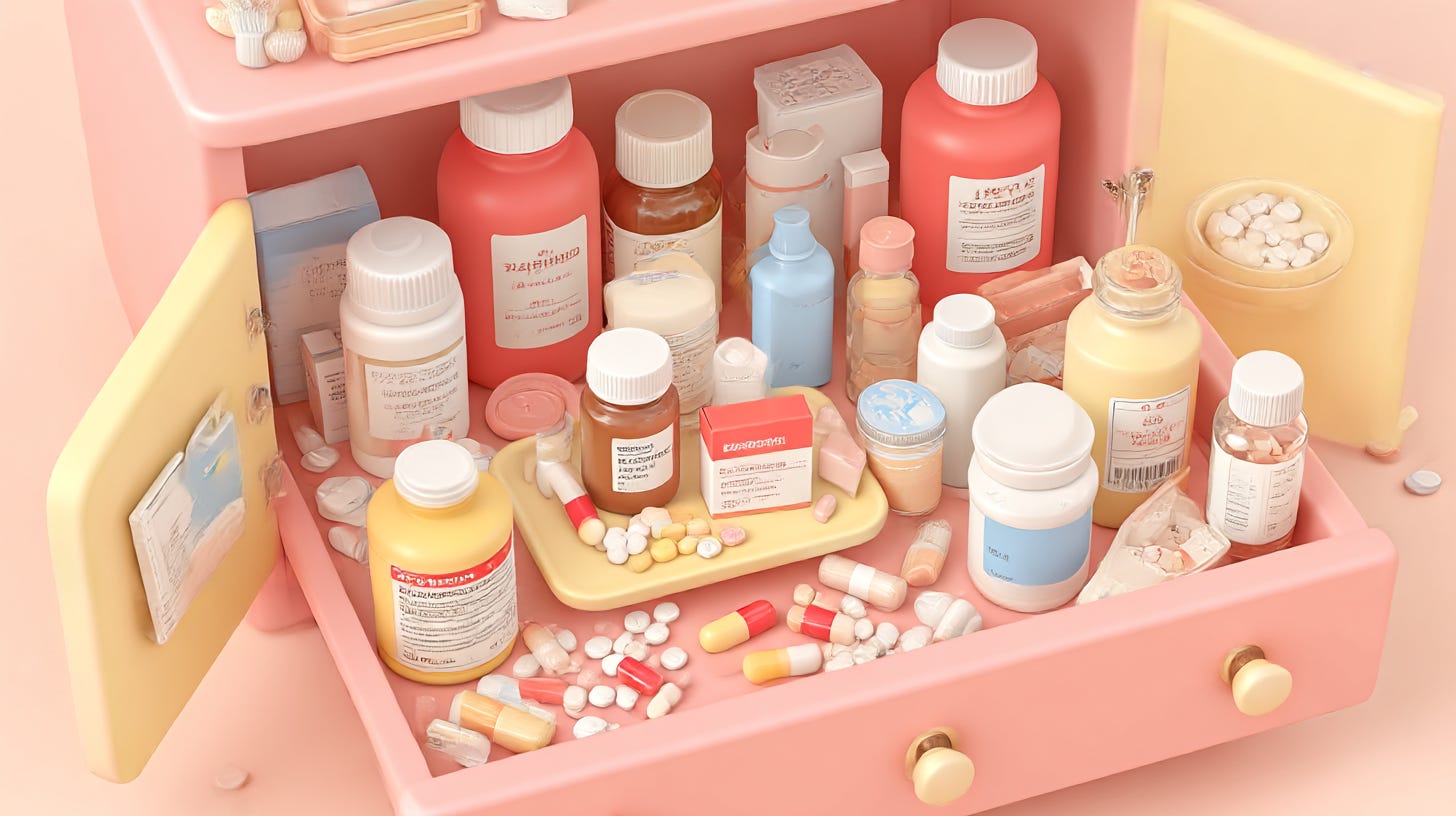Three Easy AI Prompts to Fix Your Chaotic Medicine Cabinet
Is your medicine cabinet in shambles? Do you have medicine that expired 19 years ago? This is the help you've been looking for.

Hello, friends.
I found six bottles of ibuprofen last Saturday.
Six.
I was trying to find ibuprofen for both my wife and myself. We’d been working in the yard, getting it ready for our move to Las Vegas early next year. And because we’re not exactly young anymore, and because yard work sucks, our whole bodies were aching.
The oldest bottle of ibuprofen one expired in 2019. The newest still had the price sticker from CVS. I kept buying new ones because I could never find the ones I already had.
If your medicine cabinet looks like mine did, you know exactly what I’m talking about. Mystery pills in unmarked bottles. Prescription medications from 2020. Three different antacids, because you can never remember which one actually works.
It’s not just messy.
It’s dangerous.
Expired medications lose effectiveness. Some become harmful. You’re wasting money on duplicates you can’t find. And in a real emergency? You can’t waste time digging through chaos.
This weekend, you’re going to fix it.
I’m giving you three very easy AI prompts that can help you organize your entire medicine cabinet. You’ll know exactly what to keep, what to throw away, and where everything goes.
No complicated systems. No expensive organizers. Just 90 minutes and these three prompts.
Prompt 1: The Cabinet Inventory
This first prompt creates a complete list of every medicine you have. AI asks questions one at a time, so you don’t get overwhelmed.
Open Claude, ChatGPT, or Gemini and paste this:
I need to organize my medicine cabinet and create an inventory of everything I have. Please help me by asking questions one at a time about what’s in my cabinet.
For each medication or health product, ask me about:
- The name
- Whether it’s prescription or over-the-counter
- The expiration date if I can find one
- Approximately how full the container is
- What I use it for
After I’ve told you about everything, create a simple organized list grouped by category (pain relief, cold and flu, first aid, prescriptions, etc.). Number each item so I can reference them easily.
Don’t overwhelm me with all the questions at once—just ask about one item at a time, and I’ll tell you when I’m done.What You’ll Get
AI will ask about one item at a time. You answer. When you’re done, it gives you a clean, numbered list organized by category. Save that list—you’ll need it for the next prompt.
This took me maybe 15 minutes. I just stood in front of my medicine cabinet and told AI what I was looking at
Prompt 2: What to Keep and What to Toss
Now you need to know what’s actually safe to keep. Not all expiration dates mean the same thing. Some medications are dangerous after they expire. Others just lose effectiveness.
Copy this and paste it with your inventory list:
Here’s my medicine cabinet inventory: [paste your list here]
For each item, tell me:
1. Whether it’s safe to keep or should be thrown away
2. A simple explanation of why
3. If it’s a duplicate of something else I have
4. Any special storage tips
Please go through the list item by item, using the numbers from my inventory so I can check things off as I go. Keep your explanations simple and practical.
At the end, tell me if there are any important medications I should have but don’t seem to have.What You’ll Get
AI walks through your entire inventory, item by item, and tells you exactly what to do with each thing.
When it analyzed my list, I learned all six ibuprofen bottles were fine to keep—but I only needed two. That prescription antibiotic from 2020? Needed to go immediately. Old antibiotics can be harmful.
My daily multivitamin? It should be on the kitchen counter where I’d actually remember to take it.
Prompt 3: Your Custom Organization Plan
You know what you’re keeping. Now you need to know where it goes.
This final prompt creates a simple system so you never buy duplicates again.
Based on the inventory items I’m keeping, create a simple organization plan for my medicine cabinet.
Ask me questions to determine how many medicine cabinets or pantries I have—and where they ae located in the house—where I tend to keep medicine.
Consider:
- What I use daily should be most accessible
- What I need in emergencies should be easy to find quickly
- Items I use together should be stored together
- I want to avoid ever buying duplicates again
Give me specific placement instructions, like “Top shelf, left side” or “In a small basket on the second shelf.”
Also suggest any simple organization tools I might need, but keep it simple—I don’t want to spend $100 on fancy organizers.
Finally, give me a step-by-step action plan for this weekend: what to throw away first, what to clean, and what order to put things back in.What You’ll Get
A complete organization plan customized for your cabinet and your habits.
Mine told me to put daily vitamins in the kitchen. Keep a small first aid basket on the top shelf. Store pain relievers front and center because that’s what I reach for most.
It even gave me the step-by-step order: throw away expired items first, wipe down the shelves, then organize by frequency of use.
This Week, Just Do It
You don’t need fancy containers or a complete overhaul.
You need 90 minutes, these three prompts, and a trash bag.
I did this entire process last weekend. Three nights ago, I woke up at 2 AM with a headache. Half-asleep, I grabbed the ibuprofen from exactly where I knew it would be.
No digging. No squinting at labels in the dark. No wondering if it was expired.
That’s what organization actually feels like.
Try the first prompt this weekend and see what you find. Hit reply and tell me what surprised you most about what’s in your cabinet.
— Jeremy




